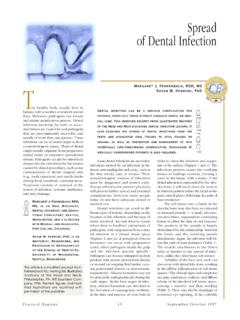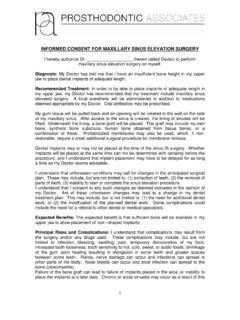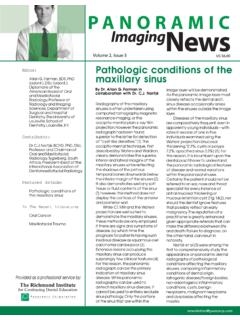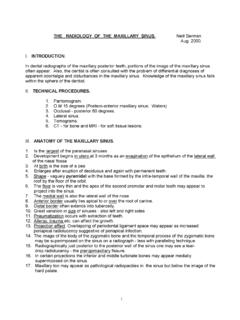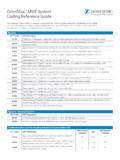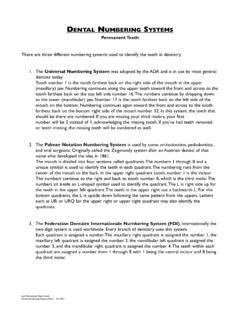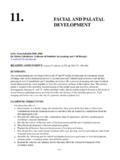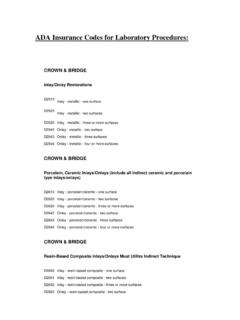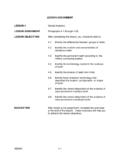Transcription of Gow-Gates Mandibular Nerve Block: feature An Alternative ...
1 34 NOVEMBER 2002accessA Gow-Gates technique is indicated for use in quadrantdentistry in cases where soft-tissue anesthesia from the mostdistal molar to midline is needed, and where conventionalinferior alveolar Nerve block (IA block) is unsuccessful. Itssuccess rate is greater than 95% higher than that of IAblock and in many cases only one injection is required formandibular anesthesia. Its lower positive aspiration rate alsois an advantage, being 2% instead of the 10 15% associatedwith IA technique is named after Dr. GeorgeGow-Gates, who championed it as a successful Alternative tothe IA Gow-Gates Mandibular Nerve block is a truemandibular block, since it anesthetizes almost the entiremandibular division of the trigeminal Nerve (mandibularnerve or V3). This Nerve is a short main trunk formed wherea smaller anterior trunk meets a larger posterior trunk in theinfratemporal fossa before it passes through the foramenovale of the sphenoid bone (Figure 1).
2 2 Thus, the nervesanesthetized with a Gow-Gates Mandibular Nerve block arethe inferior alveolar, mental, incisive, lingual, mylohyoid,auriculotemporal, and buccal (long) nerves in about 75% ofpatients (Figures 2 4). Target Area and Injection Site for Gow-GatesMandibular InjectionThe target area for the Gow-Gates technique is theanteromedial border of the Mandibular condylar neck, justinferior to the insertion of the lateral pterygoid muscle(Figure 5). The injection site intraorally is on the mucosa onthe mesial of the Mandibular ramus, just distal to the heightof the mesiolingual cusp of the maxillary second molar, fol-lowing a line extraorally from the intertragic notch of the earto the labial commissure of the same side (Figures 4 6).Note that the right-handed clinician is seated at the eighto clock position for an injection on the right side, facing thepatient.
3 The same clinician would sit at 10 o clock, facingthe same direction as the patient, for an injection on the leftside (the position of a left-handed clinician would be a mir-ror image of these positions). These are the same positions asthe inferior alveolar Nerve block. The patient should besupine, although semisupine is , the clinician locates the intertragic notch andcommissure as extraoral landmarks. This is accomplishedwith a thumb on the condyle, while the patient extends theneck and opens the mouth comfortably wide for the injec-tion (Figure 7). With the mouth open, the condyle canassume a more frontal position, bringing the injection sitecloser to the Mandibular Nerve trunk. With the mouth lessopen, the condyle will move out of the injection site and thesoft tissue become Mandibular Nerve Block: An Alternative in Local Anesthetic UseBy Margaret J.
4 Fehrenbach, RDH, MSFigure 1. The pathway of the Mandibular division of thetrigeminal division of the trigeminal Nerve is highlighted,which is truly anesthetized by the Gow-Gates mandibularnerve block (used with permission from Anatomy of theHead and Neck,2nd and Herring,WBSaunders, 2002).clinicalfeatureaccessNOVEMBER 200235 The use of a long 25-gauge needle is recommend-ed. Initially, the needle isplaced just inferior to themesiolingual cusp of themaxillary second molar toassess the approximate verti-cal coordinate for the injec-tion needle is thenrepositioned distal to themaxillary second molarmaintaining the establishedheight (Figure 8). The barrelof the needle is maintainedover the contralateral-canine-to-premolar region, so thatthe angulation of the syringeparallels a line connectingthe commissure and theintertragic notch of the sameside.
5 The orientation of thebevel of the needle tip is notcrucial for the block to besuccessful. The needle isinserted parallel to the determined lineand slowly advanced until it makesbony contact with the neck of thecondyle (Figure 9). The average depthof penetration is around 25 mm, similarto that of the IA block, although varia-tion can be considerable. Depending onthe patient's size, the height of insertionFigure 2. The pathway of the anterior trunk of the Mandibular division of the trigeminal Nerve ishighlighted, which includes the (long) buccal Nerve that is anesthetized with the Gow-Gatesmandibular Nerve block (used with permission from Anatomy of the Head and Neck,2nd and Herring, WB Saunders, 2002).Figure 3. The pathway of the posterior trunk of the Mandibular division of the trigem-inal Nerve is highlighted, which includes the auriculotemporal, lingual, inferior alveo-lar, mental, incisive, and mylohyoid nerves that are anesthetized by the Gow-Gatesmandibular Nerve block (used with permission from Anatomy of the Head and Neck,2nd ed.)
6 Fehrenbach and Herring, WB Saunders, 2002).Figure 4. Area anesthetized by a Gow-Gates Mandibular Nerve block is high-lighted and includes almost the entiremandibular Nerve (used with permis-sion from Anatomy of the Head andNeck,2nd and Herring,WB Saunders, 2002).36 NOVEMBER 2002accessabove the Mandibular occlusal plane is 10 25 mm (greaterthan for IA block). The site of injection will be just distal toa third molar if one is there is no bony contact, the injection should not begiven. Once contact with bone has been made, the needleshould be withdrawn 1 mm, aspiration performed, and thenthe agent deposited. The volume of local anesthetic agentdeposited is between and ml, since the Nerve is thickand more than one cartridge may be needed. Most cliniciansstart with one cartridge and then add a portion of a aspiration occurs less than 2% of the bone is not contacted, the needle should be with-drawn slightly and redirected more anteriorly, so that thesyringe is located more distally.
7 If there is a positive aspira-tion and blood enters the cartridge, the needle is too farbelow the target area; the internal maxillary artery or its larg-er tributaries have been nicked. This injection is most oftenmissed if attempted too the injection, the patient should sit upright andkeep the mouth open for two minutes to allow diffusion ofthe agent through the many anatomical structures. Some cli-nicians use a rubber bite block. Five to seven minutes shouldbe allowed before proceeding with dental treatment, whichis two to three minutes longer than for the IA Effects and Possible Complications ofa Gow-Gates Mandibular BlockThe Mandibular teeth to midline, the buccal mucope-riosteum and mucous membranes, and lingual soft tissuesand periosteum will be anesthetized. Inadvertently, the ante-rior two-thirds of tongue,floor of mouth, body ofmandible, and inferiorramus, as well as the skinover the zygoma and pos-terior cheek and temporalregions, are disadvantage ofthe Gow-Gates techniqueis the anesthetization ofthe lower lip, as well as thetemporal area.
8 Anotherdisadvantage is theamount of time before theanesthetic takes effect; aGow-Gates injection takeslonger to work becausethe Nerve trunk beinganesthetized is larger, andfarther from the site ofdeposition (5 10 mm).3 The injection also lasts longer than the IA block because theinjection site is less vascular and a larger volume of anesthet-ic may be needed. The injection is contraindicated inpatients with a limited ability to open the mouth; however,trismus is rarely 5. Target area for the Gow-Gates Mandibular nerveblock is located at the anteromendial border of themandibular condyle neck, just inferior to the insertion of thelateral pterygoid muscle (used with permission fromAnatomy of the Head and Neck,2nd andHerring, WB Saunders, 2002).Figure 6. The extraoral line that is followed for the Gow-Gates Mandibular Nerve block. The lineextends from the intertragic notch of the ear to the same side labial commissure (used with permis-sion from Anatomy of the Head and Neck,2nd and Herring,WB Saunders,2002).
9 AccessNOVEMBER 200237 References1. Malmed SF: Handbook of Local Anesthesia,4th ed. Mosby, St. Louis, Fehrenbach MJ, Herring SW: Illustrated Headand Neck Anatomy, 2nd ed. Saunders,Philadelphia, Bath-Balogh M, Fehrenbach MJ: IllustratedDental Embryology, Histology, and Anatomy, Saunders, Philadelphia, J. Fehrenbach, RDH, MS, is a private-practicedental hygienist who performs local anesthesia as anexpanded function. She is also an adjunct facultymember at East Tennessee State University, JohnsonCity, Tennessee, and Marquette University, Milwaukee,Wisconsin. She also presents continuing educationnationally and internationally. She may be reached byemail at or through her Web site She would like to thankDoreen Naughton, RDH, BS, Dental Health Services,Seattle, Washington, for her help in obtaining the clini-cal : With additional education, examination, andlicensure, dental hygienists in many states are allowedto administer local anesthetics.
10 Since each state has itsown specific regulations regarding the dental hygien-ist s responsibilities, the author urges readers to contacttheir respective state licensing board for informationand specific regulations concerning injections for localanesthesia. Careful research has been conducted toensure that the information and recommendations con-tained herein are accurate and compatible with thestandards of care generally accepted at the time ofpublication. The author disclaims any liability, loss, ordamage incurred as a consequence, directly or indi-rectly, of the use and application of any of the contentsof this 7. The injection site for the Gow-Gatesmandibular Nerve block is probed at the softtissues just distal to the height of the mesiolin-gual cusp of the second molar, following a lineextraorally from the intertragic notch to thelabial commissure of the same side (used withpermission from Anatomy of the Head andNeck,2nd and Herring,WBSaunders, 2002).
